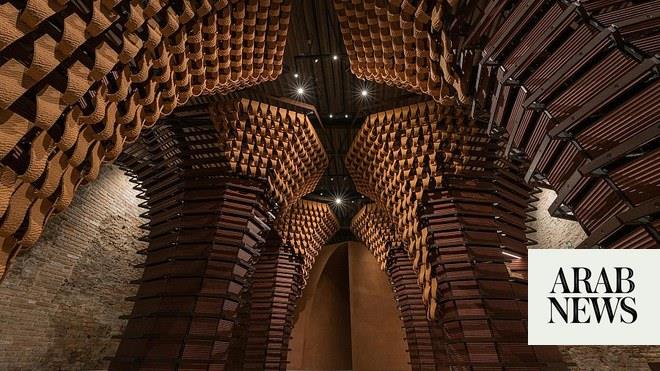
Displayed as part of the main exhibition, the Anastas brothers’ work showcases new ways of using stone in contemporary design
DUBAI: Bethlehem-based Palestinian architects Elias and Yousef Anastas, founders of the architectural firm AAU ANASTAS, presented their latest work “All Purpose” at the main exhibition of the Venice Architectural Biennale on May 22. While it was the opening night of the biennale, back in the architects’ homeland several Palestinian families in the East Jerusalem neighborhood of Sheikh Jarrah were being evicted from their homes. It was a twofold feat for the architects: one, due to the fact that the biennale had finally opened after a long postponement due to the coronavirus, and secondly, the exhibition unexpectedly served as a way to relay a message about Palestine, its architecture and materials, during a time of tension and uncertainty.
For the latest updates, follow us on Instagram @arabnews.lifestyle
For the Anastas brothers, founders of the architectural firm AAU ANASTAS, the exhibition unexpectedly served as a way to relay a message about their homeland, its architecture and materials, in a time of tension and uncertainty.
Situated in the Giardini, within the main exhibition of the Venice Architecture Biennale, All Purpose, created by AAU ANASTAS in collaboration with Professor Maurizio Brocato at Ensa Paris Malaquais, is an installation that looks at the state of stone in contemporary architecture in Palestine.
Palestinian architects Elias and Yousef Anastas, founders of the architectural firm AAU ANASTAS, presented their latest work ‘All Purpose’ at the main exhibition of the Venice Architectural Biennale. (Anotnion Ottomanelli)
The Anastas brothers, founders of Local Industries, a design platform that works with Palestinian artisans, have long championed the preservation of local craft techniques through functional contemporary design.
The exhibition serves as a reflection of the use of stone and its potential in contemporary architecture. Its title, All Purpose, refers to the versatility of stone as well as its many meanings for Palestine.
Their installation at the Venice Architecture Biennale presents a roof made of patch-like shapes that are “as minimally curved as possible” to reduce waste in the carving of the stone as well as machine fabrication time. The roof is supported by about 15 slender columns.
“The overall shape of the roof is curved while each piece composing it is as little curved as possible with regards to the total number of stone voussoirs,” Elias Anastas told Arab News. “The only sophisticated part is the interface between stones, which are all doubly curved congruent surfaces.”
A digital rendering of ‘All Purpose.’ (Supplied)
“We have been researching stone construction for eight years now, experimenting with various 1:1 scale prototypes and constructions,” Elias and Yousef told Arab News. “Locally, we are challenging the misuse of stone as a cladding material only, the repercussions of a law we inherited from the British mandate in Palestine that has had implications on architecture, urbanism, politics, culture and the environment that are disastrous.”
The use of stone has long been instrumentalized as a political tool in the conquest of Palestinian territory, dating back to the early 20th century to the time of the British mandate. Stone quarrying is Palestine’s greatest export — although quarries in Palestine operate under various Israeli restrictions.
“Globally, we are challenging the absence of stone in contemporary architecture as well as how particular stone techniques have been historically presented as an imported knowledge,” the Anastas brothers said. “Part of our research aims at desacralizing the use of stone. Once you start scratching the surface, you realize that not only have techniques always been a blend of knowledge from different civilizations, but also that in Palestine, for instance, stone has been a major part of domestic and common architecture.”
Through their work the architects challenge what they call “the imperial idea of transmission of knowledge.” To that end they have launched a sub-project within their research called Analogies, whose main aim is to trace analogies between architectural elements across time and space. A few examples, according to the brothers, include the details surrounding the stone entrance of the crusader-built church Saint Anne in Jerusalem, which were actually found in Cairo, Egypt and date to the Mamluk period.
“We globally fight for a multi-polarization of knowledge,” the architects said. “In stone architecture, for example, stereotomy is often associated with the crusaders as masters of stone. However, following traces of stone techniques and architectural forms often leads to much more diverse origins.”
In line with its name, although it was unplanned, All Purpose also had another role during the opening weeks of the Venice Architecture Biennale that coincided with the conflict taking place in the Anastas brothers’ homeland.
In the middle of the renewed fighting between Hamas and Israel in May, they wondered what to do with the popular Radio Alhara, an online radio station that was launched in Palestine at the beginning of worldwide lockdowns in March 2020. For the past year it has provided a platform for discussion, listening and community building. Its name, which means “the neighborhood radio,” echoes the nature of the station itself; an intimate community from the margins that is open and accessible to the world with the mission of bridging cultural boundaries.
“We shut down the radio to have some time to reflect on what to do and very quickly we decided to turn the radio into a platform known as the Sonic Liberation Front,” Elias Anastas said. “It is for anyone who would like to contribute any form of sonic content that is either expressing a form of solidarity with what was happening or to express other forms of injustice or oppression that are happening in other parts of the world.”
During the opening week, All Purpose became a stage for the Sonic Liberation Front launched by Radio Alhara during the Venice Biennale. The space under the vault was used to create in-situ performances by sound artists Moe Choucair and Lawrence Abu Hamdan. Both artists based their work on recordings of ambient sounds from Gaza and Jerusalem.
“Through Radio Alhara we perceived the planet becoming one, especially after the times we lived in during the pandemic,” the architects said. “The Sonic Liberation Front aims to create space to discuss, through art and sound, forms of oppression, injustices and racism happening around the world.”
While rooted in Palestine, both All Purpose and The Sonic Liberation Front share the mission of strengthening global solidarities that stem from diverse contexts in an attempt to fight as the architects state “an imperial reading of our cultures.”











